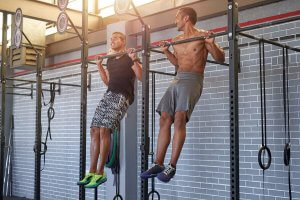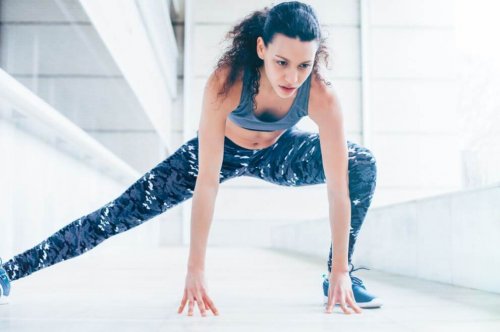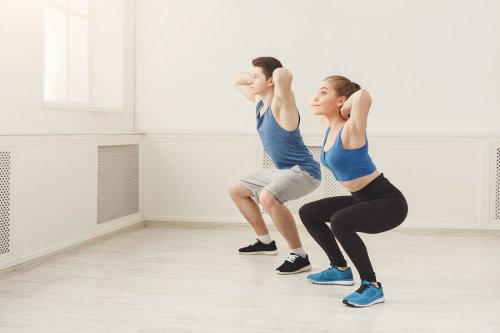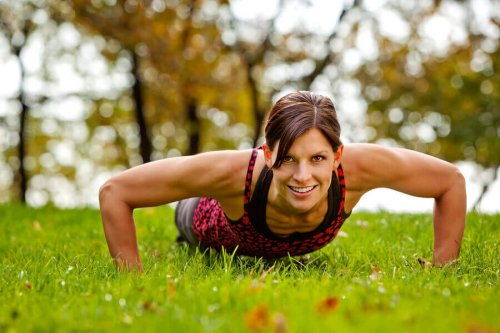Functional Training for Beginners

Nowadays, there are several alternatives to choose from for practicing physical activity. However, functional training for beginners has many followers thanks to its characteristics. Up next, we’ll review the keys to start this practice and the exercises that best adapt to a basic level.
What is functional training for beginners?
Functional training is one of the fitness trends that’s currently causing the greatest uproar, despite the fact that few people clearly define what it’s about.
Functional exercises are simple tasks we can perform with the whole body and in different planes of movement; largely imitating movements that we perform on a day-to-day basis.
One of the primary objectives of functional training is the continuous search for transfer. This refers to the gains in strength or coordination transferred to the activities of daily life or to sports in order to improve performance and reduce the risk of injury.
Another characteristic of functional training, especially at the beginning, is the use of the body itself almost exclusively. Subsequently, different elements are included once you gain dominance over your body.
Who can practice it?
This is a very appealing fact: anyone who wants to better themselves or improve can do functional training. Although, we must all know our own limits at first.
For that, it’s best to seek advice from a professional in sports sciences, who will execute an initial assessment and act as a guide to avoid any problems. In this sense, one of the key points of functional training from an initial level will be progression.

Benefits of functional training for beginners in everyday life
If you train your body comprehensively with functional exercises, you’ll enjoy several benefits, such as the following:
- Better balance.
- Increase in postural control.
- Improvements at a coordinative level.
- More strength for daily activities.
- Greater sports performance.
- The probability of suffering an injury reduces, both in sports activities and in your daily life.
Five functional training exercises for beginners
If you want to start practicing functional training, we’ll show you the five most recommended exercises.
1. Squats
It’s one of the most important exercises when training the lower section. Without going any further, a traditional squat will imitate the movement we make when we sit and get up from a chair.
We must ensure the correct execution of this movement since this exercise demands a lot from the knees. At the same time, we have to maintain a proper back alignment, which is essential for reducing the risk of injury.

2. Lunges
Lunges, along with squats, are one of the best exercises when exercising our lower section. In our daily lives, we can simulate a wider stride as we walk.
Depending on the objective, when we execute them, it’s possible to perform them forward or backward, or in a dynamic or static way. For proper execution, it’s essential to never let the knee go beyond the tips of the toes.

3. Push-ups
Push-ups are also a fundamental functional exercise. This is one of the best ways to train the thrust force we use in many everyday tasks. Its practice puts our upper body muscles to work, especially the pectorals, arms, and the core area.
At first, it’s convenient to perform the push-ups with knee support. Once you have enough strength, you can eliminate that support. Again, the principle of progression also comes into play with this exercise.

4. Pull-ups
Before, we mentioned thurst movements. In this case, we refer to traction movements, which have the same importance as the first ones. A great way to train tractions is with a well-known exercise called pull-ups. With its practice, we’ll work the back muscles as well as the arms and abdominal area.
At first, it’s advisable to have the support of your feet to do tractions. Once you gain strength, you can discard body support until you make your first pull-up.

5. Trunk rotations
Rotational trunk movements should be a priority in functional training since lots of people injure their backs during torsion movements. One of the exercises that’s very adaptable is the oblique twist with an elastic band. We must hold it with both hands and rotate the trunk to exercise the core area.
If you want to start or include functional exercises in your training routines, start with these exercises. You can master them in a short timespan and keep moving forward. Moreover, you’ll notice their effects on your daily life, which will help you stabilize all your muscles. You’ll be able to use your body to the fullest without worries!
Nowadays, there are several alternatives to choose from for practicing physical activity. However, functional training for beginners has many followers thanks to its characteristics. Up next, we’ll review the keys to start this practice and the exercises that best adapt to a basic level.
What is functional training for beginners?
Functional training is one of the fitness trends that’s currently causing the greatest uproar, despite the fact that few people clearly define what it’s about.
Functional exercises are simple tasks we can perform with the whole body and in different planes of movement; largely imitating movements that we perform on a day-to-day basis.
One of the primary objectives of functional training is the continuous search for transfer. This refers to the gains in strength or coordination transferred to the activities of daily life or to sports in order to improve performance and reduce the risk of injury.
Another characteristic of functional training, especially at the beginning, is the use of the body itself almost exclusively. Subsequently, different elements are included once you gain dominance over your body.
Who can practice it?
This is a very appealing fact: anyone who wants to better themselves or improve can do functional training. Although, we must all know our own limits at first.
For that, it’s best to seek advice from a professional in sports sciences, who will execute an initial assessment and act as a guide to avoid any problems. In this sense, one of the key points of functional training from an initial level will be progression.

Benefits of functional training for beginners in everyday life
If you train your body comprehensively with functional exercises, you’ll enjoy several benefits, such as the following:
- Better balance.
- Increase in postural control.
- Improvements at a coordinative level.
- More strength for daily activities.
- Greater sports performance.
- The probability of suffering an injury reduces, both in sports activities and in your daily life.
Five functional training exercises for beginners
If you want to start practicing functional training, we’ll show you the five most recommended exercises.
1. Squats
It’s one of the most important exercises when training the lower section. Without going any further, a traditional squat will imitate the movement we make when we sit and get up from a chair.
We must ensure the correct execution of this movement since this exercise demands a lot from the knees. At the same time, we have to maintain a proper back alignment, which is essential for reducing the risk of injury.

2. Lunges
Lunges, along with squats, are one of the best exercises when exercising our lower section. In our daily lives, we can simulate a wider stride as we walk.
Depending on the objective, when we execute them, it’s possible to perform them forward or backward, or in a dynamic or static way. For proper execution, it’s essential to never let the knee go beyond the tips of the toes.

3. Push-ups
Push-ups are also a fundamental functional exercise. This is one of the best ways to train the thrust force we use in many everyday tasks. Its practice puts our upper body muscles to work, especially the pectorals, arms, and the core area.
At first, it’s convenient to perform the push-ups with knee support. Once you have enough strength, you can eliminate that support. Again, the principle of progression also comes into play with this exercise.

4. Pull-ups
Before, we mentioned thurst movements. In this case, we refer to traction movements, which have the same importance as the first ones. A great way to train tractions is with a well-known exercise called pull-ups. With its practice, we’ll work the back muscles as well as the arms and abdominal area.
At first, it’s advisable to have the support of your feet to do tractions. Once you gain strength, you can discard body support until you make your first pull-up.

5. Trunk rotations
Rotational trunk movements should be a priority in functional training since lots of people injure their backs during torsion movements. One of the exercises that’s very adaptable is the oblique twist with an elastic band. We must hold it with both hands and rotate the trunk to exercise the core area.
If you want to start or include functional exercises in your training routines, start with these exercises. You can master them in a short timespan and keep moving forward. Moreover, you’ll notice their effects on your daily life, which will help you stabilize all your muscles. You’ll be able to use your body to the fullest without worries!
All cited sources were thoroughly reviewed by our team to ensure their quality, reliability, currency, and validity. The bibliography of this article was considered reliable and of academic or scientific accuracy.
- Bliss, LS and Teeple, P. Core stability: The centerpiece of any training program. Curr. Sp. Med. Rep. 4: 179-183, 2005.
- Boyle, M. (2004). What is functional training? Functional Training for Sports. Human Kinetics.
- Bryant, C.X. (1999). 101 frequently asked questions about health & fitness and nutrition & weight control. Sagamore Publishing.
- DiStefano, Lindsay J; Clark, Micheal A; Padua, Darin A. (2009). Evidence Supporting Balance Training in Healthy Individuals: A Systemic Review. Journal of Strength & Conditioning Research. 23(9)
This text is provided for informational purposes only and does not replace consultation with a professional. If in doubt, consult your specialist.








